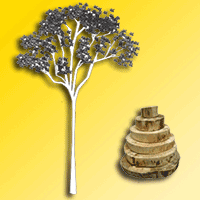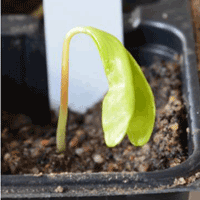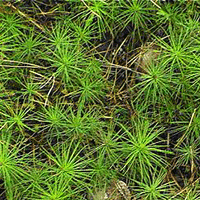
Frost damage to eucalypts in a short-rotation forestry trial in Cumbria (England)
Andrew D Leslie (1) , Maurizio Mencuccini (2), Mike Perks (3)
iForest - Biogeosciences and Forestry, Volume 7, Issue 3, Pages 156-161 (2014)
doi: https://doi.org/10.3832/ifor1161-007
Published: Jan 23, 2014 - Copyright © 2014 SISEF
Research Articles
Abstract
Cold is the main climatic constraint to planting eucalypts in Britain and the winter of 2009-2010, the coldest in thirty years, proved particularly challenging for their survival. Damage to transplants planted in May 2009 of two species of eucalypts, Eucalyptus gunnii and Eucalyptus nitens, were assessed over the winter of 2009/2010 at a trial in Cumbria, northern England. Larger trees were found to have exhibited less cold damage by the end of January 2010, but by May there were no significant differences in survival due to tree size. By late January, there were statistically significant differences in damage between E. gunnii and E. nitens with the former being more cold tolerant. However, damage at the end of January, after minimum temperatures of -14 oC, did not appear serious, yet by May the survival of E. gunnii was 37% and for E. nitens was less than 1%. As larger trees exhibited relatively less frost damage it is recommended that intensive silviculture be practiced to ensure trees are between 1 and 1.5 m tall prior to their first winter to reduce the extent of damage through frost.
Keywords
Authors’ Info
Authors’ address
National School of Forestry, University of Cumbria, Penrith Campus, Newton Rigg, CA11 0AH Penrith, England (UK)
School of Geosciences, University of Edinburgh, Crew Building, The King’s Buildings, West Mains Road, EH9 3JN Edinburgh, Scotland (UK)
Centre for Forestry and Climate Change, Forest Research Northern Research Station, EH25 9SY Roslin Midlothian, Scotland (UK)
Corresponding author
Paper Info
Citation
Leslie AD, Mencuccini M, Perks M (2014). Frost damage to eucalypts in a short-rotation forestry trial in Cumbria (England). iForest 7: 156-161. - doi: 10.3832/ifor1161-007
Academic Editor
Marco Borghetti
Paper history
Received: Oct 22, 2013
Accepted: Jan 13, 2014
First online: Jan 23, 2014
Publication Date: Jun 02, 2014
Publication Time: 0.33 months
Copyright Information
© SISEF - The Italian Society of Silviculture and Forest Ecology 2014
Open Access
This article is distributed under the terms of the Creative Commons Attribution-Non Commercial 4.0 International (https://creativecommons.org/licenses/by-nc/4.0/), which permits unrestricted use, distribution, and reproduction in any medium, provided you give appropriate credit to the original author(s) and the source, provide a link to the Creative Commons license, and indicate if changes were made.
Web Metrics
Breakdown by View Type
Article Usage
Total Article Views: 57985
(from publication date up to now)
Breakdown by View Type
HTML Page Views: 47440
Abstract Page Views: 4870
PDF Downloads: 4178
Citation/Reference Downloads: 21
XML Downloads: 1476
Web Metrics
Days since publication: 4344
Overall contacts: 57985
Avg. contacts per week: 93.44
Citation Metrics
Article Citations
Article citations are based on data periodically collected from the Clarivate Web of Science web site
(last update: Mar 2025)
Total number of cites (since 2014): 5
Average cites per year: 0.42
Publication Metrics
by Dimensions ©
Articles citing this article
List of the papers citing this article based on CrossRef Cited-by.
References
Site limits to achieving genetic potential. Eucalypt plantations: Improving Fibre yield and quality. Theme 5, Ensuring sustainable production, CRC for Temperate Hardwood Forestry. IUFRO, Hobart, Tasmania, pp. 325-330.
Gscholar
Soil data sheet for the Newton Rigg trial. Internal report, CEH - Centre for Ecology and Hydrology, Penicuik, Midlothian, UK, pp. 1.
Gscholar
The potential suitability of provenances of Eucalyptus gunnii for short rotation forestry in the UK. Quarterly Journal of Forestry 102 (3): 185-194.
Gscholar
Photosynthesis of Eucalyptus nitens is reduced by mild frosts in Eucalypt plantations: improving Fibre yield and quality. CRC for Temperate Hardwood Forestry, IUFRO, Hobart, Tasmania, pp. 339-343.
Gscholar
Eucalyptus nitens genetic parameters. New Zealand Journal of Forestry Science 38 (1), p102-119.
Gscholar
Eucalypts for short rotation forestry: a case study from the 1980s. Quarterly Journal of Forestry 105 (2): 109-117.
Gscholar
A model of frost impacts on seasonal photosynthesis of Eucalyptus pauciflora. Australian Journal of Plant Physiology 25: 27-37.
Gscholar
Physiology of frost resistance in Eucalyptus. In: “Collogue International sur les eucalypts au froid”. Nangis (France) 26-30 September 1983. AFOCEL, Nangis, France, pp. 107-125.
Gscholar
The biology of eucalypts. Studies in Biology No. 61, Edward Arnold, London, UK.
Gscholar
Combating climate change - a role for UK forests. An assessment of the potential of the UK’s trees and woodlands to mitigate and adapt to climate change. The Stationery Office, Edinburgh, UK.
Gscholar
Frost resistance in Eucalyptus nitens (Deane and Maiden) Maiden: Genetic and seasonal aspects of variation. Australian Journal of Forest Research 17: 29-47.
Gscholar
Genetic parameters for cold hardiness in Eucalyptus nitens (Deane and Maiden) Maiden. Silvae Genetica 52 (3-4): 89-97.
Gscholar

















